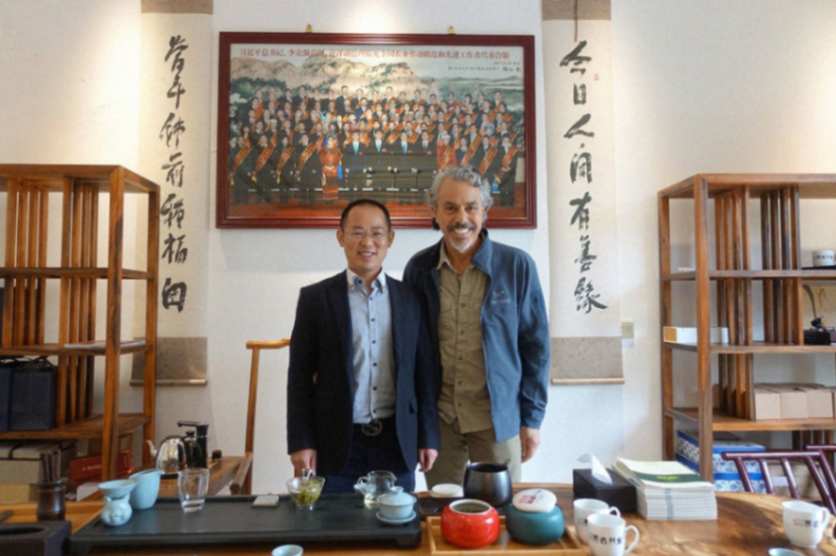At the end of March 2019, I traveled to China to investigate a rare and superior source of green tea. I had previously journeyed to China many times and had seen tea plantations in Hangzhou, Yunnan, the mountains of Sichuan, Ya’an, and several other spots. But I had not been to Hunan Province, to the tea plantations in that region. From my home in Massachusetts I flew west across the U.S., and from there to Shanghai across the vast Pacific Ocean. With more than 26 million people, Shanghai is both China’s largest city and the nation’s financial heart. With ultra-modern services, Shanghai is a major hub for getting into and out of the country.
Not everybody takes off halfway around the world when they want to know more about the source of a nutritional botanical. But I have a different idea about such things. I believe it’s vital to know as much as possible about critically valuable sources of herbal extracts. There is a whole world of herbal ingredients to explore, and it’s my mission to share that world with you.
Once on the ground in Shanghai I met with the primary team I’d be traveling with: Tracy Chen and Calvin Yang of the Chinese company Novanat, and Kathy Xiao of Italy-based Indena. All are involved in the chain of trade that results in a special extract of green tea called Green Tea Phytosome®. Together we would travel to the source of that extract, outside of the city of Changsha in China’s southeastern Hunan Province.

Chris Kilham with full bins at Jinjing Tea.
Green Tea, The Herb
All tea, whether it is green, white, orange pekoe, oolong, black or any of the other variation, comes from the same plant: Camellia sinensis. The primary difference among these types of tea concerns fermentation. Green tea is harvested and dried without fermentation. All other teas are fermented, anywhere from just a little to a lot. A sophisticated knowledge of helpful bacteria has enabled Chinese tea producers to craft some of the finest and most diverse teas in the world. The strain of plant, the place of cultivation, the soil, air and water of a region all determine whether one or another form of tea is best. In the case of the main plantation we were visiting in Hunan Province, green tea was the focus.
Nobody knows when somebody first tried tea and liked it. But there is a good possibility that at some point a person ate some tea leaves and felt stimulated. The rest is history. Tea was first cultivated in China’s Sichuan Province about 4,000 years ago, and today tea is cultivated widely throughout diverse growing areas all around the country.

The fields where Jinjing harvests its tea.
Jinjing Tea
Our team flew from Shanghai to the city of Changsha. Hunan is the home of China’s hottest and spiciest food, and our first lunch gave us an introduction to the perilously hot food we’d be enjoying during our stay. Hunan is famous for a type of very hot red chili pepper that is used in huge quantities in almost all dishes in the region. It is impossible to avoid the heat. You either like it, or you perish in an inferno of spices.
About an hour’s drive outside of Changsha we arrived at Jinjing Tea, a 6,000-hectare plantation featuring rolling hills of verdant tea terraces. Local people work in the plantations and earn a living from their tea work. Women from nearby villages harvest the tea during the months of March through October. During harvest, as many as 1,000 women from the region pick tea. Agricultural work is never easy, but the conditions at Jinjing are what you’d want to see. The place is beautiful and clean, there is fresh water and sanitary facilities for people who work there, and the facilities all around the farm are beautifully kept. Because of their environmentally responsible growing methods, natural systems of pest control and the fine working conditions, Jinjing has been endorsed as a model of sustainability by the World Wildlife Federation.
We met the plantation manager, Joe (top photo), who showed us around and also sat with us to taste tea. Joe not only manages Jinjing, but his family started the business. That first tasting was part of an educational process that we repeated every day we were there. Joe explained to us about different teas, their quality, and how to make the perfect cup. We drank tea continuously throughout our visit, tasting different varieties and style.
Tea has grown in the region where Jinjing is located for about a thousand years. And a tea industry of drying and packaging has flourished in the region for about 400 years. Jinjing Tea itself is a relative newcomer, starting just 61 years ago. But Jinjing is like a fine winery, known and admired throughout the region for its superior product. The farm produces about 2,000 tons of high quality dry green tea per year.

Jinjing's tea harvesters.
Tea Culture
For people in China, tea isn’t just a drink. An entire multi-millennia culture has arisen around tea. Tea agriculture is advanced in China, with various regions producing famous signature teas. A classic example of this is Pu’er from China’s southwestern Yunnan province, a favorite tea throughout the country. The employment of highly specialized bacteria in fermentation, the original stock of the plants, and regional growing conditions add up to great variations in flavor, aroma and quality.
Almost everybody in China drinks green tea. It shows up as a matter of course on the table at meals. People drink a lot of it. And yes, there is tremendous variation in the quality of teas. In the case of Jinjing, we were dealing with the crème de la crème of green teas, a strain that had been selected for its unusually rich beneficial antioxidant content, flavor, and aroma. During one of the days we spent at Jinjing Tea, we met a professional tea taster named Mr. Lo who patiently explained and demonstrated to us how to assess and grade tea. He determines the grade—and thus the market value—of all the tea that is grown and sold by Jinjing on the basis of color, clarity, aroma, and flavor. With his eyes, nose, and tongue he set the standards. We drank along with him, admiring many cups Jinjing produces, and came away with a greater appreciation for the true sophistication of tea tasting.
Jinjing Tea runs its own café and tasting center, with a prominent view of the tea fields and long vistas of the surrounding countryside. There we met Miss Wu, who served us some magnificent green tea. As a green tea drinker, I could appreciate the significant difference between what I typically consume on a daily basis at home and the tea we were served at Jinjing. To apply liquor terminology, it was top shelf. My friends and I relaxed and took the time to savor the cups we were offered, which is part of the whole purpose of tea drinking. At times you simply prepare a good cup of tea, and sit and relax, enjoying the vapors of the brew, the color, the taste.

Left: Tea, dried and ready for testing. Right: Freshly harvested tea leaves.
Processing
Jinjing Tea runs a large, modern tea-drying facility that dries out the once-tender leaves so they can be stored for long periods of time. We observed cool air drying and conveyors carrying green tea into warm air chambers. Getting the temperature, humidity, and drying times exactly right is a science, one that is well developed at Jinjing. The process is ingenious, and it represents a modern variation on earlier methods that involved slow-fire drying and much more hand work. At the end of the entire process, perfectly dried green tea is ready for packaging or storage.

The Gao Qiao tea market is populated with barrels of many different types of tea.
At A Tea Market
In Changsha, we headed into the center of the city to the Gao Qiao tea market—several blocks of tea shops of all sizes, selling everything from large lots of bulk teas to specialty varieties, tea tables, pots, cups, and various accoutrements of tea service. If you wanted to, you could spend thousands of dollars putting together a tea set-up that includes a custom-made table, special burners and pots, various cups, matching chairs—the works! There, we browsed several shops, talked with owners, smelled samples, and admired many fine teas. Changsha is the epicenter of tea commerce in Hunan Province, and the Gao Qiao market plays a vital role in that trade.

Chris Kilham visited many different areas in China tasting tea.
Extraction At Novanat
In Changsha we traveled to the Novanat extraction facility, where every year 600 tons of green tea is extracted using a clean method featuring water and pure alcohol—an incredibly efficient and safe way to extract herbs. The factory manager, Mr. Longe, showed us around. We toured the manufacturing plant—a modern facility with stainless steel equipment, excellent quality control systems, and all the testing systems you would hope to find. The extract that is produced at Novanat uses tea from Jinjing Tea, and then goes to Milan, Italy, to Indena, where it is transformed into Green Tea GreenSelect® Phytosome® by blending the extract with phospholipids derived from lecithin. This results in a radically better absorbed extract, one that also enjoys several human clinical studies backing its efficacy, including its support for weight management and fat loss.

Left: Mr. Jiang welcomes Chris Kilham to Yunshang. Right: Chris gets acquainted with bundles of tea.
The Road To Yuntai
Departing Changsha, we set off for Anhua, a three-hour journey that took us further out into the Chinese countryside. Along the way, huge bamboo stands covered entire hills and mountains. We followed rivers in several places. Once in Anhua, we checked into another hotel and readied ourselves for the following day—our journey to fabled Yuntai Mountain.
Even though our green tea extract comes from the fields at Jinjing, Yuntai Mountain occupies a special significance in the tea history of Hunan. In 1957, researchers discovered a rare strain of tea on Yuntai Mountain whose characteristics were unlike those of any other previously discovered. This specific, large leaf tea was ideal for making black tea. The exciting discovery led to the broad distribution of that strain and other strains descendent from it all over China. In fact, some of the tea grown at Jinjing derives from that strain.
On the top of cold, rainy, windswept Yuntai Mountain we stopped at Yunshang Tea, an 11-year-old company whose reputation for exceptionally fine black tea is already widely known. The manager of the business, Mr. Jiang, showed us around the premises where various tasting rooms were set up for guests. But before sampling the tea, we went out into the cold and rain and walked along high walkways up the mountain to the tea plantations. It was a strange sensation to be actually walking through clouds, which as they shifted would alternately cover or reveal previously unseen terraces of tea. Moody, misty and mysterious, it was a fabulous setting. The air was fresh and the sight of the clouded tea gardens seemed as if they were from a different dimension.
Back at Yunshang, we enjoyed a long tasting with Miss Chen, with whom we spent a couple of hours sampling unimaginably large amounts of tea. It went on for a long time, as we smelled and tasted different “pourings” of tea. The same pot of tea leaves might be used six or seven times, with each yielding a different flavor, aroma, and color. That day we learned a lot about this iconic drink, and we each agreed that we enjoyed more tea in that one sitting than at any other point in our lives.
Mr. Jiang explained to us that the secret to making the black tea at Yunshang cannot be shared with a non-Chinese person. To do so actually constitutes a crime. But what he could share was that the tea there is inoculated with a bacteria called Eurotium cristatum, which breaks down the cell walls of the tea leaves, bringing out distinct flavor and aromatic characteristics. The fermentation lasts 15 days, and the subsequent drying process takes another 15 to complete. This process yields a unique black tea, certainly one of the finest I have ever tasted.
In the warehouse at Yunshang, we looked at many hundreds of bundles of tea in sizes ranging from one kilogram to a couple of hundred kilograms in weight. All of them were perfectly wrapped tightly in natural fiber to preserve their integrity. We also watched a small group of people in the Yunshang factory make bricks of tea—hard-pressed tea scored like chocolate bars. We learned that tea can be pressed into many different forms, which can then be stored for long periods.

Left: Pressed tea from Yuntai Mountain. Right: Tea is the elixir of life at Yuntai.
Conclusion
Everywhere our small group went, we were greeted warmly and welcomed with gracious hospitality. The people at Jinjing Tea, the Changsha Gao Qiao tea market, Novanat extraction and Yunshang Tea all took time to show us around, help us to understand their work, and educate us about tea and its infinite subtleties. My friends from Novanat and Indena made the trip a pleasure and arranged countless details for our journey. The kindness of all these people made our expedition to Hunan a success.
In the end we saw what we needed to see: the source of the green tea extract we use in many of our Purity Products® nutritional supplements, along with the chain of trade from harvest to finished extraction. And we get to share this with you, so you gain a better understanding of the world of herbs and specialty botanicals!









